Help needed for new research...

For the past four years, Stephanie
Fleig has been busy monitoring lots of our agility dogs to see
just how they have coped with the excitement and anticipation of competing in new situations,
paying particular attention to what happens behaviourally and physiologically whilst they are
standing in the queue waiting for their turn in the ring. This work commenced whilst Stephanie
was studying for her degree and now forms the basis of her Ph.D. Although this work is still
on-going, she has been allowed to share some of her results with us...
 It's funny how something so simple as dogs
jumping fences and negotiating obstacles which is, after all, something dogs do lots of whilst
out on a country walk, has become the most popular and fastest growing doggy sport here in the
UK. It's funny how something so simple as dogs
jumping fences and negotiating obstacles which is, after all, something dogs do lots of whilst
out on a country walk, has become the most popular and fastest growing doggy sport here in the
UK.
I remember thinking the first time I saw
agility on the telly just how excited and happy the dogs appeared to be and I marvelled at the
special bond that surely must exist between dog and owner. What I didn't appreciate back
then was the hours of dedicated training required to achieve that bond and also the ability of
both dog and owner to run and complete the course. Those thoughts date back
probably 20 years ago but now, but after having been privileged enough to have worked alongside and
studied lots of amazing agility dogs and their owners for the past four years, I
realise just how much work goes into building that very special bond....and I am
even more in awe.
I am also very thankful that I choose to do my
honours degree in Animal Welfare & Behaviour at Myerscough College, near Preston (Lancs), where agility
training and competitions are held on a regular basis. As part of your degree - the honours bit
- you are able to choose your own scientific study and the obvious choice for me was the
agility dogs.
 After spending several hours watching
the dogs at training, I was curious to see if all the excitement and anticipation was affecting their heart
rate. What I found was that their heart rates increased at different stages during the evening.
When they were standing in a queue waiting their turn in the ring, their heart rates were
much, much higher. After spending several hours watching
the dogs at training, I was curious to see if all the excitement and anticipation was affecting their heart
rate. What I found was that their heart rates increased at different stages during the evening.
When they were standing in a queue waiting their turn in the ring, their heart rates were
much, much higher.
More in-depth research brought to light a
couple of quotes 'standing in the queue prior to performing affects behaviour and success in
the ring' and 'performance dog stress affects welfare and behaviour.' After attending
several shows just watching what was happening, I turned to you for your thoughts on queuing.
Many of you will recall back in 2011 the questionnaire which I placed onto Agilitynet. Once
again I would like to say thank you to the 1000 respondents - that was amazing feedback.
I promised back then I would let you all know
how my research was progressing. This has for lots of reasons taken much longer than I would
have liked, but I hope you will find the following report interesting. It is very basic as
there is still lots of analysing going on and also lots more data to collect, so it is all very
exciting.
This work will provide comprehensive and novel insight
into how competing agility dogs cope both behaviourally and physiologically. It will also aid
identification of environmental, physical and social factors at organised agility shows that
may influence competing dog welfare. It is hoped that by the end of the study, information
packs will also be made available to help owners identify and address early behavioural signs
of anticipation and anxiety, thus improving their own dogs welfare at organized shows.
The research will furthermore highlight to the general public that dog agility is proactive and
seeking to understand how sporting canines cope in these environments.
 What are we trying to achieve? What are we trying to achieve?
A preliminary study has already been undertaken and these initial findings were presented at
the Kennel Club Seminar back in November 2012. Work
continued during 2013 and plans are afoot for the outdoor season of 2014. Continued work will enable us to complete
the journey toward both an improved understanding of factors that may be influencing the
welfare of dogs during completion and subsequently identification of strategies that could help
to
improve welfare at competitions.
What
we did...
In 2011-2012 we measured the dog's heart rate at
home while they were resting, whilst they were standing by the owner's car/caravan prior to
them entering the showground and then again after they had been standing in the queue for about
five minutes.
We observed their behaviour whilst they
were standing in the queue waiting to perform.
We also conducted an on-line survey (1,000
respondents)
What we found...
Heart rates
We found that there was a significant rise in heart rate from resting to the one taken
before they entered the showground which was to be expected, but we then found a further
increase in HR in all of the study dogs whilst they were standing in the queue waiting to
perform. These increases were statistically significant; but are nonetheless comparable with
racing greyhound's heart rates whilst they are watching other greyhound's race.
We also found that heart rates were
consistently higher in dogs when they were participating at the indoor shows both pre-queue
and standing in the queue. When we compared the heart rate of all of the dogs at day one of a
show against day 2 of the same show, we also found that the heart rates of all the dogs had
increased on the second day.
Heart rates had also increased when
we compared the dogs first run of the day with its last run of the day. We also found that
dogs that had been competing at agility for more than three years had higher heart rates in
the queue than dogs that had been competing for less than three years. Initially we thought
this could be to do with the dog's age, but further analysis proved this not to be the case.
 Behaviour Behaviour
From our behavioural observations we found that all of our dogs lip-licked whilst they
were standing in the queue. As would be expected this behaviour was observed at different
frequencies per minute in the individual dogs. Lip lick is a very ambiguous behaviour; it may
simply mean the dogs are trying to calm the situation down, but, because of its variety of
interpretations it requires further monitoring to ascertain what the dogs are trying to
communicate to us.
On-line Survey (brief outline)
-
21% of owners said that they were
happy with the way that dogs are queued at outdoor shows
-
68% of owners said that they were
concerned queuing influenced their dog's welfare
-
27% of dogs have been attacked by
other dogs whilst standing in the queue
-
38% of owners felt that their dog's
emotional state varied depending on the size and venue of the show
What we did in 2013...
Again we measured the dog's heart rate
at home while they were resting, and then from leaving the owners car / caravan to just prior
to them entering the ring, but this time the dog's heart rate was monitored continuously
using a Polar human heart rate monitor.
We also measured the same dog's heart
rate whilst it was on a routine familiar walk in home surroundings, for comparison.
Once again we observed behaviour whilst
they were standing in the queue waiting to perform and also whilst on a routine walk for
comparison.
 What we found... What we found...
Heart rates
As before significant increases were seen in heart rate from resting to those taken at the
shows. Heart rates were also found to be significantly higher in dogs whilst at shows
compared to those taken on a routine walk. Heart rates were also considerably more variable
at shows than when on a walk, reflecting their reactivity to their surrounding environment. Initial findings also suggest that individual venue has a significant effect on HR, as does
the length of time dogs have been competing.
Behaviour
This is still in the process of being analyzed, but behaviours such as body, tail and ear
posture are also being included this time round.
What is planned for 2014?
We are looking to use lots more dogs,
again Border Collies and Working Sheepdogs. Sticking to just the one breed makes the data much
more meaningful. We hope to attend the same and different venues to once again re-test what we
have already found, we need to be sure. This time we also plan to compare findings with those
measured during routine training sessions and those of sheepdogs at competition trials. We are
also planning to measure urinary cortisol concentrations in some of our dogs. Cortisol is
considered to be the chief stress hormone and this will help us quantify our findings.
It may be that owners new to agility
would appreciate some kind of owner awareness information, and we would be looking to produce
some kind of package to help in this way. But most of all we are looking at ways to improve the
welfare of dogs that may perhaps be finding agility a little overwhelming.
Please can you
help...
If you are interested in helping us with our work
during the 2014 season and fit in with the initial participation criteria (below) we would love
to hear from you. At the moment, we are especially looking for participants that
will be attending the Lune valley show at Milnthorpe in June/July and would be happy for us to
monitor your dogs heart rate, video your dogs behaviour and collect morning urine samples to
measure cortisol : creatinine concentrations.
 Monitoring
the heart rate is very simple. All we need to do is place the monitor around your dog's chest,
using a stretchy belt. In order to create a good contact, we normally wet a small area of fur.
So far none of our dogs have been concerned about the stretchy belt but, obviously if they did
become anxious, the belt would be removed immediately. Monitoring
the heart rate is very simple. All we need to do is place the monitor around your dog's chest,
using a stretchy belt. In order to create a good contact, we normally wet a small area of fur.
So far none of our dogs have been concerned about the stretchy belt but, obviously if they did
become anxious, the belt would be removed immediately.
We have hired one of the rings at
Milthorpe on Wednesday, 2 July. We are planning to set up a jumping course in the morning and
an agility course in the afternoon. Participants will have the opportunity to use both during
events as a time to practice in the ring. Should owners wish to practice queuing with yug dogs
still learning the ropes, then we are very happy for that to occur, too.
We are planning to manipulate the
queuing system by means of a dedicated spacing system between dogs to see whether this changes
the dog's behaviour and, for dogs wearing the heart rate monitor, also see what changes occurs
physiologically.
This is a very exciting part of the
research and, if you would like to help us out, the more the merrier. We are wanting to mimic a
real event as much as possible, so we need plenty of dogs to stand in the queue and then have
fun in the ring. There will be prizes, too. Obviously, if you would like us to monitor your
dog's heart rate too, please let us know.
We will be a both shows with an
information gazebo so you will be able to read lots more about what we are up to. You can
register for the 2nd July event there but, in terms of planning, the sooner we know, the
better.
If you would like
to help us
with our ground-breaking research, or just find out more, please contact Stephanie by
email
Initial Criteria
-
Participate with a Border
Collie/Working Sheepdog at large height
-
Participate at shows in the Midlands
and North of England
-
Happy to queue whilst waiting to
compete at shows
-
Dogs under normal circumstances do
not display any anxiety related behaviours
If you and your canine
friend are interested in helping me this summer, I would love to hear from you, initially
by email or, if you see me at the shows - I
am easily identifiable as I carry a
red bucket everywhere with me. Please do say hi...
 About the author... About the author...
Stephanie Fleig is a lifelong animal lover and when, after bringing up her family, the
opportunity arose to academically increase her knowledge, she jumped at the chance.
In 2002 she graduated with a 1st class
HND in Zoological Conservation from Plymouth University, along with first-hand knowledge of
life as a student zoo-keeper. In 2011 she graduated with a 1st class BSc (Hons) degree in
Animal Welfare and Behaviour from Myerscough College in Lancashire where she was awarded Best
Student of the Year and her 3rd year research dissertation looking at ‘Performance Dog Stress
in Agility Dogs' won her top project award. She presented this work at the Myerscough
Conference in 2011, 2012 and 2013 and also at the Kennel Clubs Sports Science Seminar in
November 2012. She is currently continuing with this piece of research for her PhD thesis.
Stephanie lives in Bolton, Lancashire
with her partner, her 10 year old rescue Border Collie called Buster and her three Maine Coon cats Shukran,
Shakira and Gizmo. When not studying, Stephanie helps fundraise for the Lancashire Wildlife
Trust and enjoys wildlife photography.
Cartoons: Kim Blundell
First published 3 April 2014
|